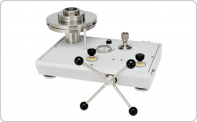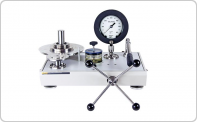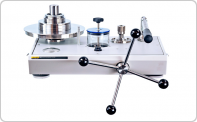- Other Fluke companies:
- Fluke
- Fluke Biomedical
- Fluke Networks
- Fluke Process Instruments
Deadweight Testers
A deadweight tester is a calibration standard that uses the principle of a pressure balance to calibrate pressure measuring instruments. Deadweight testers use calibrated weights to apply known pressures to a device under test for a simple and cost-effective solution that covers a wide range of pressure calibrations. A key advantage of using a deadweight tester is that all of the hardware required to generate pressure and precisely control and measure it can be contained within the instrument. Fluke Calibration deadweight testers are known for their best-in-class uncertainties, fast stabilization times, easy fine-adjustment, and a unique mounting post design that allows you to seal the device under test using only your fingers.
Deadweight tester calibration
Deadweight tester calibration is the act of comparing the readings of a device under test, such as a pressure gauge, to the known pressures produced by precise weights. The basic steps to perform calibration with a deadweight tester include attaching a pressure measurement device to the tester, applying a series of weights to generate known pressures, and comparing the known pressures to pressure readings from the device under test.
Advantages of using a deadweight tester to calibrate pressure measurement devices arethat they cover a wide range of pressures and offer very stable pressures when calibrating devices. The pressure stability is especially noticeable when compared to the option of pressure comparators with digital gauges.
Various names of a deadweight tester
People refer to a deadweight tester in many ways including:
- dead weight pressure tester
- dead weight calibrator
- dead weight machine
- dead weight apparatus
The difference between a hydraulic and pneumatic deadweight tester
The main differences between a hydraulic and pneumatic deadweight tester are that the hydraulic tester is operated by a liquid under pressure while a pneumatic tester is operated by air or gas. Hydraulic deadweight testers go to higher full-scale pressures while pneumatic units are more appropriate for lower pressures.
Fluke offers multiple types of deadweight testers:
- Hydraulic deadweight testers
- Pneumatic deadweight testers
- Oil deadweight testers
- Water deadweight testers
Each one is designed to generate precise pressure to calibrate pressure-measuring instruments.
Deadweight pressure testers are most often used in calibration laboratories to calibrate electronic or mechanical pressure-measuring tools, like pressure gauges or vacuum gauges. Over time, these tools can become less accurate, so it’s necessary to calibrate in order to ensure proper, consistent measurements each and every time.
How to use a deadweight tester
The following video and links to other videos show how to use deadweight testers and demonstrate how they work. Some videos demonstrate pressure gauge calibration using a deadweight tester. And there’s a video that demonstrates how to use an electronic deadweight tester and explains its benefits vs non-electric deadweight testers.
- P3100 Series Hydraulic Deadweight Tester - Video Demo
- P551X and 2700G Introduction and Demonstration Video
- E-DWT-H & 6531/6532 Electronic Deadweight Tester Video Series
Deadweight Tester Comparison Guides
- Home
- Products
- New Products
- Electrical Calibration
- RF Calibration
- Data Acquisition and Test Equipment
- Temperature Calibration
- Humidity Calibration
- Pressure Calibration
- Flow Calibration
- Process Calibration Tools
- Calibration Software
- Service and Support
- All Calibration Instruments
- Handheld Test Tools
- Purchase Info
- News
- Training and Events
- Literature and Education
- Service and Support
- About Us
Sidebar Request a Quote
Request a quote





